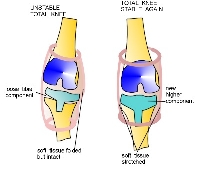
Understanding what causes knee instability can be a complicated medical question
When a knee becomes unstable it is often the result of damaged ligaments. The ligaments are responsible for keeping the knee intact and in place. When a ligament suffers damage and can?t function at top capacity this is what results in unpredictability.
Ligaments are at risk for injury especially when a person is engaged in twisting movements when playing sports. When a ligament is harmed, the forces in the joint are not in balance and this is what causes knee instability.
Wearing joint supports can help those who have these problems. Talk to your physician to determine which condition is causing your symptoms, what therapies are appropriate and the recommended course of treatment. Always follow a physician’s recommendations.
TORN LIGAMENTS
When a leg feels unstable it feels as though it is going to give out. If a person is experiencing this sensation it may mean that there is a tear in one of the ligaments.
If a person?s leg joint does give out this is a sure sign that he is suffering from instability and this is often the result of issues with patellofemoral dysfunction, range of motion that has been reduced and weakened quadriceps muscles.
Patellofemoral dysfunction is considered a catch-phrase that refers to various conditions that impact how the kneecap moves. If an individual is incapable of achieving full range of motion in a particular joint, this can result in instability as can weak quadriceps muscles.
The ligaments that are frequently injured include the posterior cruciate, the anterior cruciate and the medial collateral ligaments, commonly known as PCL, ACL and MCL.
~
If a ligament has fully ruptured, this can result in extreme unsteadiness at first. Doctors grade ligament sprains on a scale of 1 through 3. The Grade 1 sprain is the least serious while Grade 3 sprains usually send the patient into surgery.
If more than one ligament is damaged, this can result in both sides of the joint not being held securely in the correct position. The feeling of flux occurs when the person does side-to-side movements or twists.
When a knee is wobbly it will sublux or open up when a person is engaged in physical activities. This indicates that the kneecap isn?t tracking properly in its groove.
The difference between actual ligamentous instability and the feeling of volatility can be determined by a medical examination. Sometimes it may feel as though the joint is going to give out as a result of an injury but the ligaments aren’t actually damaged.
TORN MENISCUS
The meniscus is a crescent-shaped cartilage disk that cushions the end of a bone where it meets with another bone in a joint. When the meniscus is torn, this can cause the sensation of insecurity. The meniscus is important because it cushions the joint as well as stabilizes it.
THE PATELLA (KNEECAP)
If a person?s patella is moving out of the groove where it is supposed to sit on the femur this can create the feeling of unsteadiness. The patella lies within the quadriceps tendon. This tendon anchors the quadriceps muscle to the shin bone (upper tibia.) If the patella is struck it can be knocked out of the groove. If a person twists unnaturally, this can result in the same outcome. When the patella is dislocated, this makes it wobbly.
OSTEOARTHRITIS
If a person has developed osteoarthritis this can lead to volatility because the cartilage inside the joint becomes loose, the muscle has become weak, ligaments are torn and the meniscus is degenerating due to this condition. Pain is the result.
The loose bodies in the cartilage are small fragments that can get caught in the joint space and between the bones in the bone. This produces pain and may cause the knee to give out. These loose bodies can also result in locking and inability to straighten the leg.
